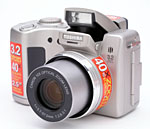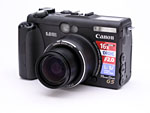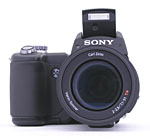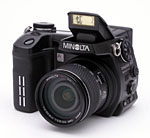What's New - August 2003
August 26
 Full
review posted for Toshiba PDR-M700!
Full
review posted for Toshiba PDR-M700!
Really long-zoom digicams are gaining popularity with users, something that surprises me not at all. - A really long-ratio zoom lens is a lot of fun, and makes a lot of shots possible that just wouldn't work with a shorter zoom. Toshiba's new PDR-M700 combines flexible exposure control with a high-quality Canon-built 10x optical zoom lens and an updated user interface. The availability of fully automatic exposure control and preset Scene selections is great for novices, while the range of manual exposure options should appease enthusiasts. Beginners will also be able to step up to increased control as they become more experienced with the camera. The 3.2-megapixel CCD delivers enough resolution for sharp 8x10 prints, and exposure, tonal balance, and color are all quite good. While I didn't initially like the M700 as much as the somewhat higher-end ultra-zoom models from Olympus, its solid performance eventually won me over. For the money, it's a very good long-zoom digicam. Good enough, in fact, for me to make it a "Dave's Pick." If you're looking for a really long-ratio zoom lens on a budget, you should give the M700 careful consideration.
Really long-zoom digicams are gaining popularity with users, something that surprises me not at all. - A really long-ratio zoom lens is a lot of fun, and makes a lot of shots possible that just wouldn't work with a shorter zoom. Toshiba's new PDR-M700 combines flexible exposure control with a high-quality Canon-built 10x optical zoom lens and an updated user interface. The availability of fully automatic exposure control and preset Scene selections is great for novices, while the range of manual exposure options should appease enthusiasts. Beginners will also be able to step up to increased control as they become more experienced with the camera. The 3.2-megapixel CCD delivers enough resolution for sharp 8x10 prints, and exposure, tonal balance, and color are all quite good. While I didn't initially like the M700 as much as the somewhat higher-end ultra-zoom models from Olympus, its solid performance eventually won me over. For the money, it's a very good long-zoom digicam. Good enough, in fact, for me to make it a "Dave's Pick." If you're looking for a really long-ratio zoom lens on a budget, you should give the M700 careful consideration.
August 22
 Review
posted for Pentax Optio 33L!
Review
posted for Pentax Optio 33L!
The Optio 33L is the latest in a series of compact, feature-packed digicams from Pentax. The 3.2-megapixel entry-level model in their line, the 33L offers good value for the money when you consider the range of features it offers, although its image quality isn't up to the standard of the higher-end Optios, or the best of the competition in its own market segment. Color is good, if slightly undersaturated, and I found its exposure accuracy to be a little variable, but the Optio 33L is unique in the entry-level market for the amazing level of functionality it provides, and unusual features it offers. (I suspect it will probably find its biggest fans among 3D enthusiasts, as it's the cheapest camera on the market with the capability to easily and accurately capture 3D stereo pairs of images.) If it had slightly better image quality, or a slightly lower street price, it might have made it as a "Dave's Pick", but it was a near miss regardless. Check out the review for all the details!
The Optio 33L is the latest in a series of compact, feature-packed digicams from Pentax. The 3.2-megapixel entry-level model in their line, the 33L offers good value for the money when you consider the range of features it offers, although its image quality isn't up to the standard of the higher-end Optios, or the best of the competition in its own market segment. Color is good, if slightly undersaturated, and I found its exposure accuracy to be a little variable, but the Optio 33L is unique in the entry-level market for the amazing level of functionality it provides, and unusual features it offers. (I suspect it will probably find its biggest fans among 3D enthusiasts, as it's the cheapest camera on the market with the capability to easily and accurately capture 3D stereo pairs of images.) If it had slightly better image quality, or a slightly lower street price, it might have made it as a "Dave's Pick", but it was a near miss regardless. Check out the review for all the details!
Review
posted for Canon PowerShot A60!
This is the "little brother" of the hugely popular Canon PowerShot
A70. It's a two-megapixel design, vs the three-megapixel resolution of the
A70, but other features and performance factors are almost identical. The
one exception I found is that its shutter lag is a *lot* slower than that
of the A70, to the point that I debated whether to make it a Dave's Pick
camera or not. I ended up deciding that its other excellent qualities and
features warranted that honor, but I included a caution about shutter lag
in it's Dave's Pick listing. Apart from the slow shutter response though,
this is an excellent little camera if all you need is two megapixels. Read
our review for more details!
August 18
 Full
review posted for Canon PowerShot G5!
Full
review posted for Canon PowerShot G5!
Back when Canon's PowerShot G3 came out, the question everyone was asking was "where's the 5 megapixel CCD?" The G3 is a very worthy camera, with myriad enhancements and upgrades relative to the G2, but the high end of the market was still clamoring for a 5 MP CCD. Well, the bigger chip is here now, in the form of the PowerShot G5, and it looks to be worth the wait. Virtually the identical camera to the G3, the larger chip in the G5 does introduce some subtle differences in slightly slower AF and shutter lag performance, and slightly higher image noise. In all other respects though, the G5 equals or surpasses the G3, making it a prime candidate for anyone looking at the 5MP end of the digicam market. - Just a really fine offering. Check it out, but make sure you have your wallet handy, you're going to want one!
Back when Canon's PowerShot G3 came out, the question everyone was asking was "where's the 5 megapixel CCD?" The G3 is a very worthy camera, with myriad enhancements and upgrades relative to the G2, but the high end of the market was still clamoring for a 5 MP CCD. Well, the bigger chip is here now, in the form of the PowerShot G5, and it looks to be worth the wait. Virtually the identical camera to the G3, the larger chip in the G5 does introduce some subtle differences in slightly slower AF and shutter lag performance, and slightly higher image noise. In all other respects though, the G5 equals or surpasses the G3, making it a prime candidate for anyone looking at the 5MP end of the digicam market. - Just a really fine offering. Check it out, but make sure you have your wallet handy, you're going to want one!
August 15
 Full-length
Preview posted for Sony DSC-F828!
Full-length
Preview posted for Sony DSC-F828!
A couple of years back, Sony really rocked the digicam world when they introduced the DSC-F707, their original 5-megapixel camera. The big sensor was noteworthy, although Minolta had just months before announced their 5-megapixel DiMAGE 7, but the F707 incorporated a range of unique, Sony-only technologies, including Hologram Autofocus and Night Framing and Night Shot exposure modes that let you literally shoot in total darkness. This time around, Sony's not willing to let anyone steal the megapixel crown before them, and so are the first to announce a prosumer digicam with an 8(!) megapixel sensor. But the sensor resolution is just the tip of the figurative iceberg with the new DSC-F828, as myriad other features have been taken to the next level, and once again there's some new, Sony-only technology on display. The F828 has a new Carl Zeiss "T*" 7x optical zoom lens, with an equivalent range from 28-200 mm, and fast f/2.0-2.8 maximum aperture. The new camera supports direct print via the new PictBridge standard, has a RAW format for the first time on a Sony camera, and is the first Sony digicam in a long while to support CompactFlash (Type II) memory cards. (It has a Memory Stick slot as well.) Sony has also cranked up the autofocus speed, giving the F828 the best shutter lag times I've seen yet in a prosumer digicam. Perhaps the biggest news though, is that the F828 uses Sony's new "RGB+E" four-color CCD technology for superior color rendition and accuracy. The sample I have to work with is an early prototype, so color isn't final (and I'm not allowed to share any photos from it), but even at this early stage of development, the color quality from the camera looks very encouraging. Full details are in my review, so check it out!
A couple of years back, Sony really rocked the digicam world when they introduced the DSC-F707, their original 5-megapixel camera. The big sensor was noteworthy, although Minolta had just months before announced their 5-megapixel DiMAGE 7, but the F707 incorporated a range of unique, Sony-only technologies, including Hologram Autofocus and Night Framing and Night Shot exposure modes that let you literally shoot in total darkness. This time around, Sony's not willing to let anyone steal the megapixel crown before them, and so are the first to announce a prosumer digicam with an 8(!) megapixel sensor. But the sensor resolution is just the tip of the figurative iceberg with the new DSC-F828, as myriad other features have been taken to the next level, and once again there's some new, Sony-only technology on display. The F828 has a new Carl Zeiss "T*" 7x optical zoom lens, with an equivalent range from 28-200 mm, and fast f/2.0-2.8 maximum aperture. The new camera supports direct print via the new PictBridge standard, has a RAW format for the first time on a Sony camera, and is the first Sony digicam in a long while to support CompactFlash (Type II) memory cards. (It has a Memory Stick slot as well.) Sony has also cranked up the autofocus speed, giving the F828 the best shutter lag times I've seen yet in a prosumer digicam. Perhaps the biggest news though, is that the F828 uses Sony's new "RGB+E" four-color CCD technology for superior color rendition and accuracy. The sample I have to work with is an early prototype, so color isn't final (and I'm not allowed to share any photos from it), but even at this early stage of development, the color quality from the camera looks very encouraging. Full details are in my review, so check it out!
August 8
 First
Look review posted for Minolta DiMAGE A1!
First
Look review posted for Minolta DiMAGE A1!
Throughout their evolution, I've been impressed with Minolta's DiMAGE series of digicams, from the 7 to the 7i, 7Hi, and now the A1. The new DiMAGE A1 is a nice upgrade to the 7Hi, adding the benefits of faster shutter speeds, a very effective Anti-Shake mode, tracking autofocus, an intelligent grip sensor to help conserve battery power, 14-bit A/D conversion, a tilting LCD monitor, and remote capture capability to an already great camera. Oh - and its battery life is *way* better than that of earlier models, the A1 in fact showing some of the best battery life I've seen from a prosumer digicam. The A1's tack-sharp, long-ratio zoom lens and (potentially) fast shutter response make it a nearly ideal camera for amateur sports shooting, while the availability of a full auto mode is perfect for novices who want to gradually learn more. (I do have to reserve judgement on the A1's shutter response until I can test a production model, as the prototype I tested was only average in this regard. Given that the 7Hi had unusually fast shutter response though, and that Minolta seems to be claiming even higher performance for the A1, I'm hopeful that production-level A1s will be very fast off the mark.) As an added bonus, the DiMAGE A1 integrates beautifully with Minolta's dedicated flash units, with built-in wireless TTL flash metering capability and full control over the flashes' zoom heads. (Minolta's very flexible twin-headed macro flash system deserves special mention here as well, as one of the most flexible macro lighting systems I've seen.) Support of Adobe RGB, including the ability to embed a color-space tag in its file headers make it well suited for use in professional, color-managed work environments. With its panoply of features and flexible control, the new DiMAGE A1 demands serious consideration from anyone shopping at the high end of the "prosumer" digicam market. The ultimate test of course will be image quality, so stay tuned for an update to this review as soon as Minolta can get me a production model to test. Meanwhile, check out my First Look review, for details on all the new goodies!
Throughout their evolution, I've been impressed with Minolta's DiMAGE series of digicams, from the 7 to the 7i, 7Hi, and now the A1. The new DiMAGE A1 is a nice upgrade to the 7Hi, adding the benefits of faster shutter speeds, a very effective Anti-Shake mode, tracking autofocus, an intelligent grip sensor to help conserve battery power, 14-bit A/D conversion, a tilting LCD monitor, and remote capture capability to an already great camera. Oh - and its battery life is *way* better than that of earlier models, the A1 in fact showing some of the best battery life I've seen from a prosumer digicam. The A1's tack-sharp, long-ratio zoom lens and (potentially) fast shutter response make it a nearly ideal camera for amateur sports shooting, while the availability of a full auto mode is perfect for novices who want to gradually learn more. (I do have to reserve judgement on the A1's shutter response until I can test a production model, as the prototype I tested was only average in this regard. Given that the 7Hi had unusually fast shutter response though, and that Minolta seems to be claiming even higher performance for the A1, I'm hopeful that production-level A1s will be very fast off the mark.) As an added bonus, the DiMAGE A1 integrates beautifully with Minolta's dedicated flash units, with built-in wireless TTL flash metering capability and full control over the flashes' zoom heads. (Minolta's very flexible twin-headed macro flash system deserves special mention here as well, as one of the most flexible macro lighting systems I've seen.) Support of Adobe RGB, including the ability to embed a color-space tag in its file headers make it well suited for use in professional, color-managed work environments. With its panoply of features and flexible control, the new DiMAGE A1 demands serious consideration from anyone shopping at the high end of the "prosumer" digicam market. The ultimate test of course will be image quality, so stay tuned for an update to this review as soon as Minolta can get me a production model to test. Meanwhile, check out my First Look review, for details on all the new goodies!
